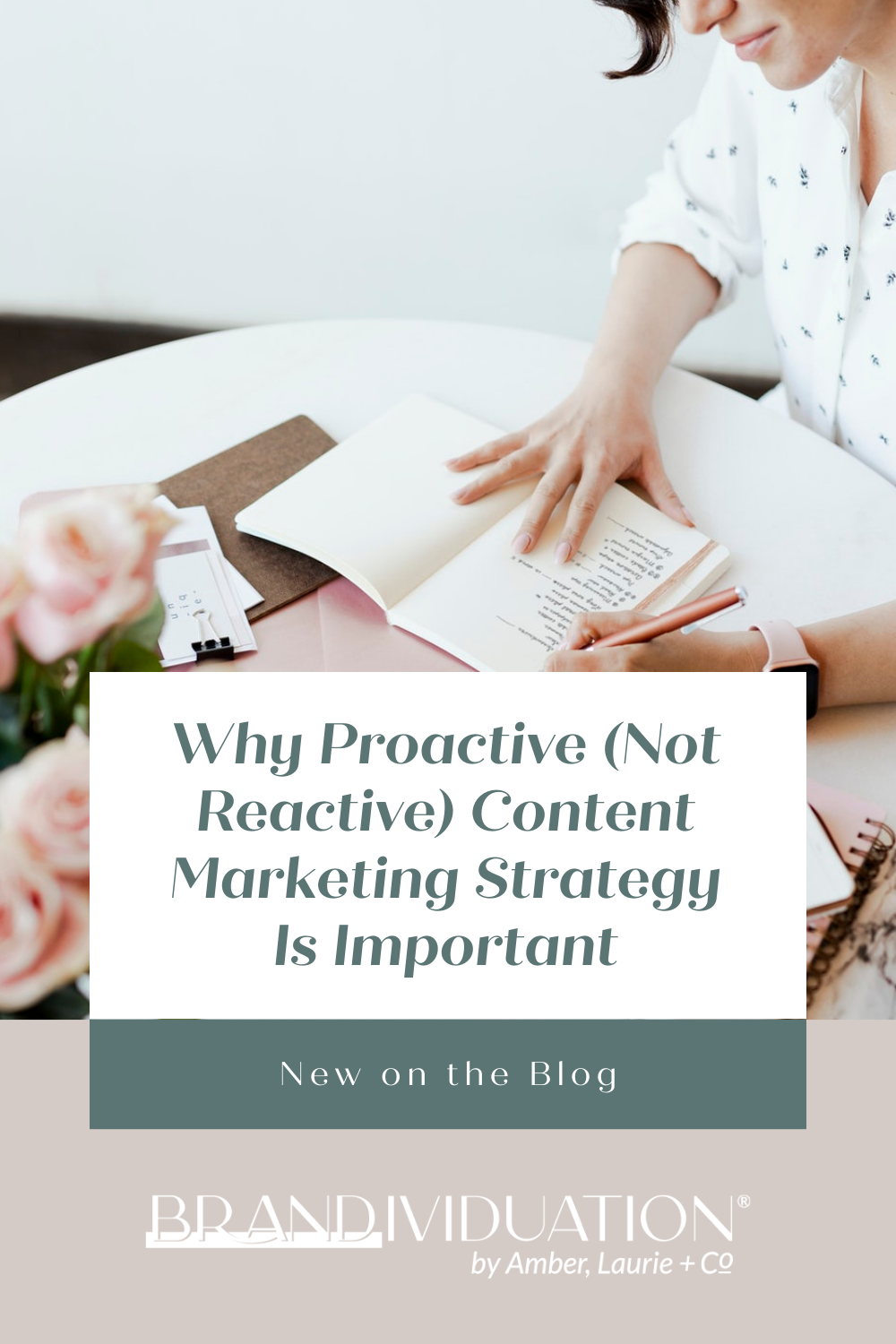Most businesses know the importance of strategic content marketing. (If you want to learn more about what content marketing strategy is and why it’s important, check out the last two articles here and here.) But, where many teams and content strategists struggle is moving from reactive content strategy to proactive content strategy.
This is something that comes up with almost every single client we work with. Businesses know that content marketing is important, but fail to see how their lack of planning negatively impacts the efficacy of their strategy and position in the marketplace.
Let me give an example.
Content Marketing Shift Example One: A Micro-influencer Consultant
Reactive Content Strategy
I’ve worked with a client in the consultancy industry who knows how important it is to establish their authority and credibility in the marketplace. Every week they were blocking time to research, write, and publish content that was relevant and timely. They would see a trend, event, or issue come up and write about it.
But, because they were coming up with new content every single week, the following was occurring:
- They were creating a lot of new work for themselves and stretching themselves thin because so much time was spent on ideation of “new” content
- There was no singular overall focus so it wasn’t super clear what their one big value to their clients was
- They weren’t making each piece of content work for them as well as they could because people were only seeing that topic the one time it was published
Now, it’s not that this approach was fruitless or non-useful. The content being published was pretty forward-thinking and avant-guard in style compared to what competitors were putting out. This consultant even garnered the attention of some big name heavy hitter influencers.
But, the content that was created with so much energy, time, and research wasn’t going as far as it could. If they’d spent time focusing on building out one big valuable meaty piece of content each month or quarter, that one big-value piece could be split into micro pieces of content that would:
- Repeatedly establish them as an authority in their field and help them be known for the things they were most able to speak on and solve for
- Give them way more time to focus on other tasks that would directly tie to revenue-generating activities, therefore increasing their profitability
- Simplify their content-creation process and allow someone else, like a VA or content creator, to take their authority piece and repurpose it into authority-building micro-messages
- Give them a way to use the methods with the least effort and the most return on investment of time, energy, and cost to create a system personalized to their brand
- Allow their content to remain focused on their unique positioning, wealth of expertise, and key messaging – therefore eliminating confusion from their target audience and further supporting their reputation as the go-to consultant in their niche
Proactive Content Strategy

Since the goals of content strategy are to increase awareness of the brand’s unique value, increase qualified leads, and boost the authority of the brand shortening the customer journey, we have to be very strategic and proactive about our content marketing.
This particular client is especially suited for proactive content marketing because they can see changes in their industry before others can. It’s kinda their gift. So, it makes sense to leverage that gift and be more proactive in their strategic content marketing plan so that others can see just how valuable this gift is and turn to them for the latest and most relevant source of information.
In order to do that, we had to shift the way content marketing was done for their business. So, I proposed they go through the marketing mapping process and content editorial calendar development. We agreed that was the best plan to move forward with.
This allows them to make sure:
- Their marketing goals and KPIs are aligned to their overall organizational goals for the year
- They’re keeping their content focused on the north star of their brand – their unique position and key pillars of their thought leadership
- Have a detailed plan for how to break their big content pieces down into bite-sized value-based content for their platforms so they have repeatable authority-building content
Why Proactive Content Strategy Is Preferable
Teams and leaders get in the habit of developing content “on-the-fly.” There’s sometimes value in that approach – especially when you’re dealing with big global events like a pandemic or civil unrest. However, all content shouldn’t be reactive. Reactive content, overall, complicates the big messages, confuses audiences, and takes teams further away from the core purpose of the brand.
It can be easy to start to lose your audience when you confuse them.
In fact, I worked in-house with a large enterprise who had reached a point where people were generally very confused about what kind of business they were and what their purpose was. They had gotten so far away from their core purpose and key messages that they were even confused about how to present it to external audiences and even internal team members.
That’s never a good thing.
To become and remain a go-to leader in your industry and niche, it’s important to stay centered on your purpose, pillar topics that your brand is built around, and key messages that are aligned to your brand and audience.
When you can build your entire annual content plan around the purpose, pillars, and audience needs, plus map it back to your organizational goals, you’re in a winning game.
How to Develop a Content Marketing Plan
In order to be proactive about your content marketing, you have to be strategic in your approach to creating the overall marketing plan. So, I want to share with you how we help our clients be strategic about their content, from the big picture goals to the granular, tiny details in daily content to be published.
Step One: Identify Organizational Goals
At our firm, everything centers on the goals and results you can get from strategic work.

If you want to be known for your unique position and thought leadership, the method is to go through the Brandividuation process to get clear on how to present that unique position to the world.
If the goal is to increase revenue by 15%, the method is to identify the highest-return marketing efforts and develop a detailed marketing plan with Key Performance Indicators (KPIs) to help you reach that goal.
So, the first step is getting very clear and specific about what goals you have for your business at the end of the year – the results you’re looking for. Without clear and specific organizational goals, you can’t be proactive in your marketing plan.
One of our most recent marketing mapping and content calendar clients wanted to increase participation in their program, expand program offerings, and generate more funding for their non-profit organization. So, we mapped the marketing goals to those organization goals so we could help them achieve them.
Marketing Goals
Once the organizational goals are clarified and articulated, the marketing goals can then be developed.
Everything has to have a reason for existing. To justify the time, energy, and budget allocated to each marketing task, it has to be clearly defined, measurable, and have a strategic purpose.
For example, if your overall organizational goals were to increase brand awareness by 20%, increase revenue by 15%, and build 3 new strategic partnerships, newsletters wouldn’t be a priority. Based on the goals we’ve just identified, nurturing the existing audience wasn’t one of our priorities. So, our marketing priorities may be to run social media campaigns and ads, run paid search campaigns, have a specific number of cold pitches per month, and schedule a specific number of discovery calls with identified strategic partner prospects.
If nurturing existing audience members is important to you, you may have other content efforts in place already that can accomplish that goal. So, it may not make sense to your organization to spend time developing and executing a new newsletter.
Everything you do in your content marketing plan must be strategic.
For that reason, it’s important to match marketing goals to organizational goals so that the methods that are appropriate to each overall business goal are identified.
For example, for our local non-profit client, we identified marketing goals to communicate with strategic partners, outreach to potential program partners, and set specific outreach goals for funding and sponsorships.
Platform & Method Specifics
While it’s important to have marketing goals established, it’s just as critical to identify the platforms and methods that will give you the most return on your investment.
The “spray and pray” method of marketing is ineffective and inefficient. You don’t have to be everywhere all the time. You have to be where your best-fit target market is when they’re there.
That’s why it’s critical you identify which platforms they most use – and even more so, which ones they respond to that lead them down a buyer journey.
Let me clarify – you might find that your audience, overall, prefers to use Facebook. But, when they’re there, they may want to focus on more personal contacts and updates from family and friends. So, seeing posts and ads from businesses may just annoy them.
But, what if they use Facebook and Instagram both and often click on Instagram ads that are relevant to them? That means you need to spend time marketing to them on Instagram and not wasting time, energy, and money on marketing to them on Facebook.
You’ll have to do some market research to find out where your ideal audience is most likely to respond or convert, but it is well worth the effort.
You’ll also want to identify the methods you use on each platform to help you reach your goals. For example, storytelling is a great way to build a connection at the entry-level point of the sales funnel. People love to hear stories and are more likely to listen to what you have to say if you give examples and lead them down a journey.
Another example of identifying methods is to use case studies to build your authority and credibility with your target audience. If they see that what you’ve done for other clients works, they’re going to be more likely to believe you can get results for them, too. For our non-profit clients, we helped them identify ways they could share the stories of those they serve and gave direction on how to use those stories in individual social media posts.
Specific Benchmarks
Once you know what kind of content marketing you’ll be using, you’ll need benchmarks, or KPIs, to measure how effective the content marketing you identified is for your business and audience.
This means you’ll set reasonable measurable goals to help you understand how your content is performing.
One example is increasing your audience by 15% each month. Or, maybe you’ve identified using gated case studies as a lead generation resource and you want to have a 3% conversion rate or 10 new qualified leads per month for that opt-in.
This is something we clearly defined for our non-profit client so they could regularly monitor and measure their content’s effectiveness.
Whatever your marketing goals are, set specific goals so you know if it’s effective for your organization.
Identification of Roles
It’s great to have a marketing plan. But, don’t let it go to waste sitting in a Google Drive somewhere. You’ll want to assign a team lead to execute and monitor your marketing plan regularly. You’ll also want to get clear on which team members will be executing on each piece of the marketing plan.
As a bonus to our non-profit client, we gave direction on how they could get their board members involved in spreading their content and gaining new brand advocates.
Quarterly Marketing Plans
The overall annual marketing plan is a wonderful tool. But, we also have to break that big yearly plan down into quarterly planning sheets so that it’s much easier to execute and maintain consistency.
Quarterly marketing plan sheets should outline the goals you will reach for the quarter, monthly themes for your content around your core pillars, and weekly topics related to the themes. This will help your team members more feasibly plan out the content so it stays aligned to the overall and marketing goals, plus maintain brand consistency as well.
This is something our non-profit client found particularly helpful. Once the plan is broken down into actionable steps, it’s much less overwhelming and easier to execute.
Monthly Editorial Calendars in 90-day Sprints
When you have your quarterly marketing plans in place, it’s so much easier to plan out the monthly content calendar. In fact, we plan out content in 90-day sprints for our clients.
You’ll want to make sure you are matching the weekly topics to relevant and well-balanced calls to action based on your company campaigns and goals.
Be careful not to make too many asks from your audience in the awareness and nurturing phases of content connection. You want to spend a lot of time getting people to know, like, trust, and engage with you at the top of the funnel.
I know that when our non-profit client and I got on our review call for their content plan and follow-up call a month later, they were particularly appreciative of this balance breakdown so they knew how to handle the number of asks they were putting out with care and poise.
Measuring Results
Marketing without results is pointless. For any marketing your team is putting effort into, you want to know it’s working for you. That’s why it’s important to regularly monitor your measurable results.
Get data on your overall growth on social channels, engagement rates, shares, comments, and likes. Monitor views, conversions, and bounce rates for your landing pages and lead generating content. Pay attention to your open rates, click rates, and unsubscribes for emails.
Document these data points monthly and analyze their consistency, or lack of, quarterly.

Adjusting the Plan to Optimize Results
It’s not uncommon for brands to have to change plans or shift goals slightly based on the response you get or don’t get from your marketing.
Marketing works and content marketing works well – when you identify the methods and platforms that work well for your specific industry and audience.
Before working together, our non-profit client was putting out content inconsistently. Often, they were only putting out content when a big campaign or fundraising event was going live. They knew that this was not effective. So, when they had their 90-day marketing plan in-hand, it was a huge relief.
Having a plan to simply execute on is a large part of the battle when it comes to being proactive with your content plan. Without this resource, teams are left to be reactive with their content marketing, leaving so much opportunity lost.
But, when you can have a simple actionable plan aligned to your overall organization’s purpose and goals, you can quickly become the go-to leader in your niche and reach those goals, however big they may be.
Need help identifying your big goals and mapping out a plan for your content marketing? Book a consultation with me and we can talk about whether it makes sense for you to go through our marketing mapping process and what that would look like.








